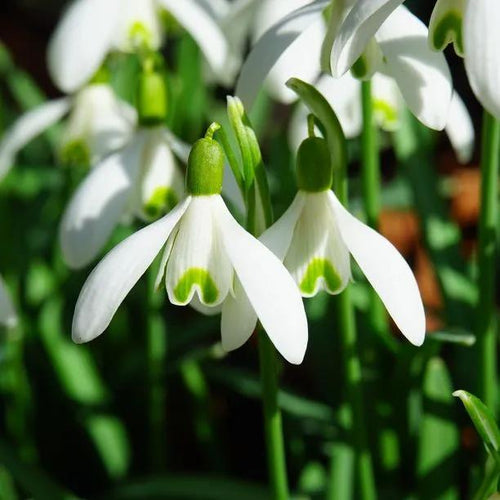Late Flowering Snowdrop Bulbs
Late Flowering Snowdrops, Galanthus ikariae, are a princess among snowdrops with virginal white outer petals and lime-green markings on the inner perianth. For galanthophiles and those who are looking for something a little bit different, Galanthus ikariae makes a change from the equally beautiful common Snowdrop, Galanthus nivalis. It'll grow in all soils, requiring some sun and the room to spread a little. The dark, matt leaves form attractive, erect clumps. Galanthus ikariae will spread over two to five years rewarding you with a snowy river of white.
Where best for Snowdrops
Snowdrops are the harbinger of spring. Since the weather isn't so clement our suggestion is to plant them somewhere obvious from your house or your car as you drive in. All snowdrops look good in a swathe down a bank, or along a drive or under a dark, evergreen hedge, lightening dark corners and providing contrast in scale. In spite of their elegant, nodding heads reminiscent of bowing courtiers, they're plucky little things to emerge at this darkest and coldest time of the year when very little else is flowering. A favourite combination is to plant snowdrops among Hellebores like Helleborus orientalis and niger, the Christmas and Lenten roses. Another thought is to underplant evergreen Viburnum bodnantense or Viburnum tinus, or the flaming whips of Cornus 'Midwinter Fire' and Cornus Sibirica to guarantee real winter wow.
Features
- Colour: White, with pale green marks on inner perianth
- Height: 15 cm
- Scent: Slight
- Flowering: January - February
- Planting Depth: 12-18cm, best planted in drifts
- Planting Months: September - November
- Foliage: dark matt green
History & Trivia
This species of snowdrop originates from several Greek islands in the Aegean sea: Andros, Ikaria, Naxos and Skyros.
It was first discovered on Ikaria, which is named after Icarus, the son of Daedalus whose wings fashioned of feathers and wax melted when he flew too high, giving us the expression "to fly too close to the sun".
The u shaped markings on the petals mimic a pair of wings.

 Secure, One-Tap Checkout
Secure, One-Tap Checkout
 Hand Picked, Delivered to Your Door!
Hand Picked, Delivered to Your Door! 1 Year Bareroot Guarantee
1 Year Bareroot Guarantee

